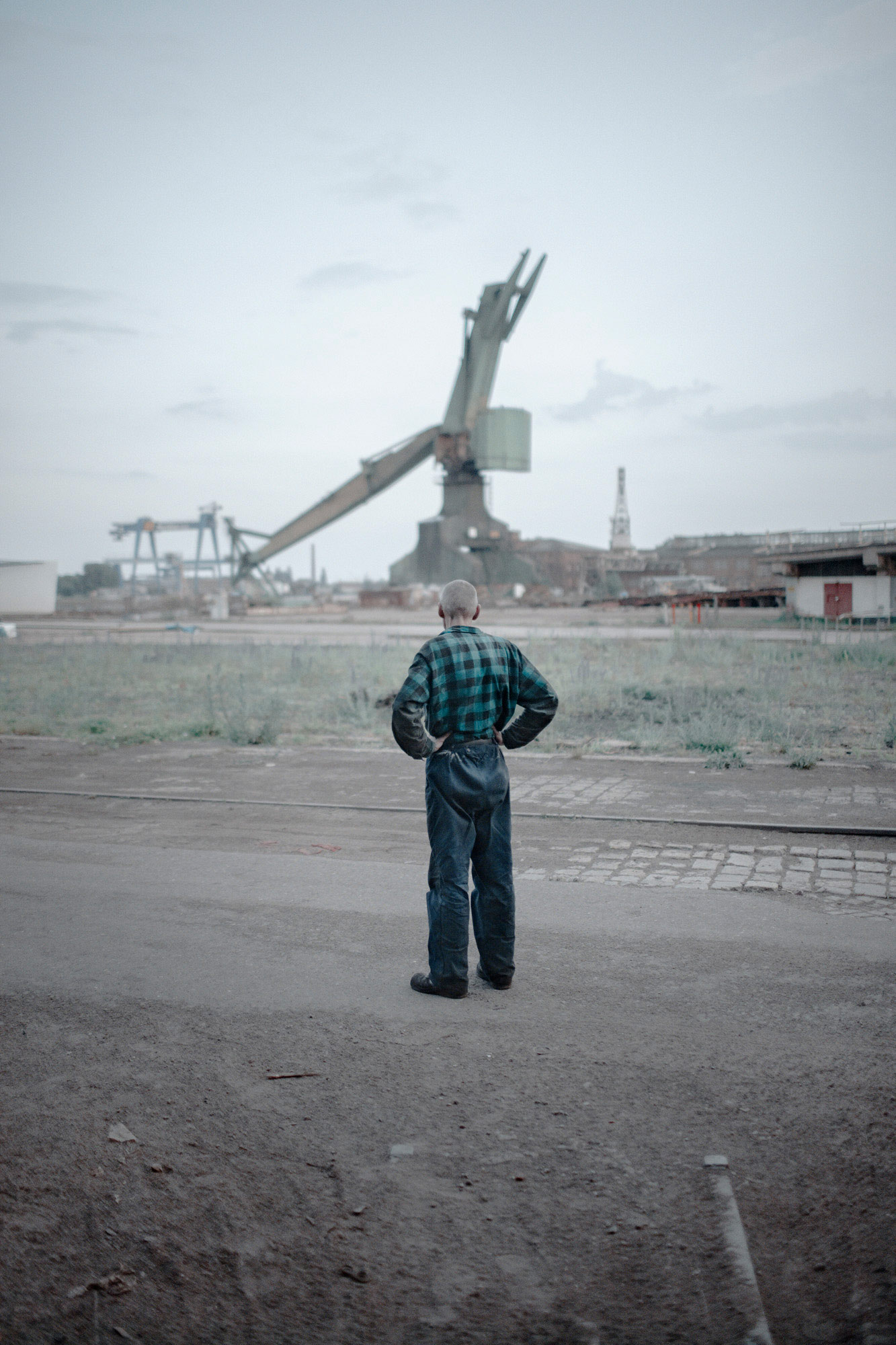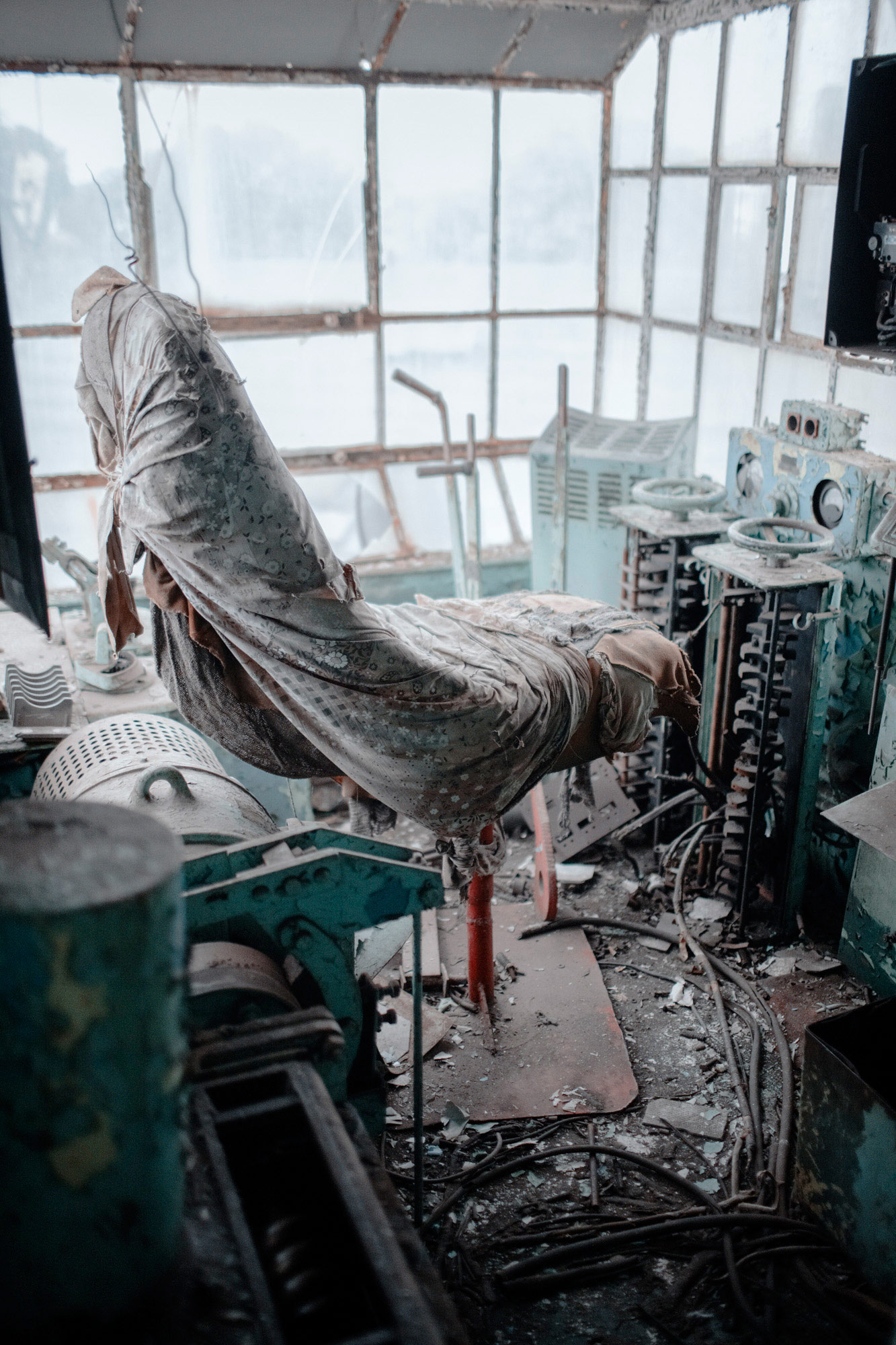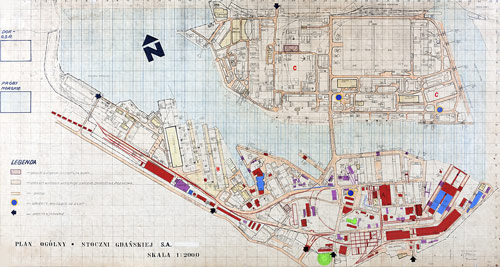-
Shipyard
Photography and text by Michał Szlaga -
Photographer Michał Szlaga mourns a lost opportunity of gargantuan proportions at the former Gdańsk shipyards – the birthplace of Solidarity.
In 1999 I was allowed access to photograph the then inaccessible Gdańsk Shipyard premises. I saw production still in progress, dozens of extraordinary buildings, amazing shipbuilding facilities, kilometres of rail tracks, overhead structures and pipelines feeding the huge industrial organism. It was a fairytale world whose glorious past, which dates back more than 150 years, gradually permeated my daily life, mainly thanks to the shipyard workers, my guides to that unique place.
In 2002, with several dozen others, I moved into the Colony of Artists established by the former shipyard’s new owners and became a permanent resident. Over the years the number of artists increased; taking over abandoned buildings as the shipyard production gradually moved to Ostrów Island. This permanent presence of artists eventually caused a change in how the shipyard was perceived, namely, as a symbol of industrial decline, and we, although acting in good faith, became a propaganda tool of the investors.
In my naïvety back then, I believed that everything would work out perfectly: that the shipyard would be reborn elsewhere and that the local decision-makers, who were descended from the Solidarność (Solidarity) movement after all, and enjoying the support of trusted, excellent architects, scientists and planners, would create something special. I believed that the new owners would turn this heritage site into a valuable asset for the city. I believed that the principle underlying the entire urban design for the new district would be to preserve as many shipyard buildings, roads, facilities and local natural features as possible. I believed that the Polish State would protect these assets and that the officials, conservators and politicians responsible would do their job well.
In 2003 a barbaric local development plan was adopted after all kinds of important initiatives had been ignored, including the chance to add the entire shipyard to the UNESCO World Heritage List. -

No comprehensive research was conducted to determine its possible historical value or to make the inventory publicly available. Moreover, the development proposal included an unfortunate traffic plan, which cut through the new district in such a way that much of its historic integrity would be destroyed. All the while, those in power continued to pretend that they had the best of intentions.
The site currently has several owners who, rather than adopt a common urban development policy for the entire area, have chosen to limit their designs to their own properties. The municipal authorities who authorised the plan can now only be passive observers of what is happening to the cultural heritage of the district.
The fate of the former shipyards architecture in Gdańsk is not unique: the Fakora radiator factory in Łódź, with its pioneering eight-bay concrete factory floor from before World War: demolished; the non-ferrous metal works in Szopienice (formerly Uthemann Mill, dating from 1834): demolished; and the early twentieth century Gottwald Coal Mine in Katowice: also demolished...
In Poland we have witnessed the dismantling of many industries. It has been a painful lesson; we have inflicted punishment on ourselves but why on earth should we punish ourselves again by erasing such important historic indicators of the past, the unique resources of our cultural heritage?
-
»It was a fairytale world whose glorious past gradually permeated my daily life«
-

Using a plan originally used by shipyard firefighters‚ Michał Szlaga has been mapping the disappearance of the site’s architecture‚ building by building. Those already demolished are marked in red. Those marked green are protected by the city conservator. The purple buildings are currently standing but their future remains uncertain. In an update to the version which appeared in his book, blue markings indicate the buildings demolished since its publication in 2013.
Michał Szlaga graduated in 2003 from the Department of Photography at the Gdańsk Academy of Fine Arts with a final degree project called Disappearing Occupations 2003 (a series of portraits of shipyard workers), and has since become well known for his documentary photography and his work as a photojournalist.
His practice is primarily preoccupied with Polish subjects, and has included the series Polska–Rzeczywistość/Poland–Reality, which looks at contemporary Polish society. His most widely acclaimed project is Stocznia/Shipyard, a monumental documentation of the demolition of the historic shipyard in Gdańsk. In 2013, he published a book based on photographic material that he had gathered for this project since 1999.
szlaga.blogspot.de
-
Search
-
FIND PRODUCTS
PRODUCT GROUP
- Building Materials
- Building Panels
- Building technology
- Façade
- Fittings
- Heating, Cooling, Ventilation
- Interior
- Roof
- Sanitary facilities
MANUFACTURER
- 3A Composites
- Alape
- Armstrong
- Caparol
- Eternit
- FSB
- Gira
- Hagemeister
- JUNG
- Kaldewei
- Lamberts
- Leicht
- Solarlux
- Steininger Designers
- Stiebel Eltron
- Velux
- Warema
- Wilkhahn
-
Follow Us
Tumblr
New and existing Tumblr users can connect with uncube and share our visual diary.
»Less is a bore.«
Robert Venturi
Keyboard Shortcuts
- Supermenu
- Skip Articles
- Turn Pages
- Contents


